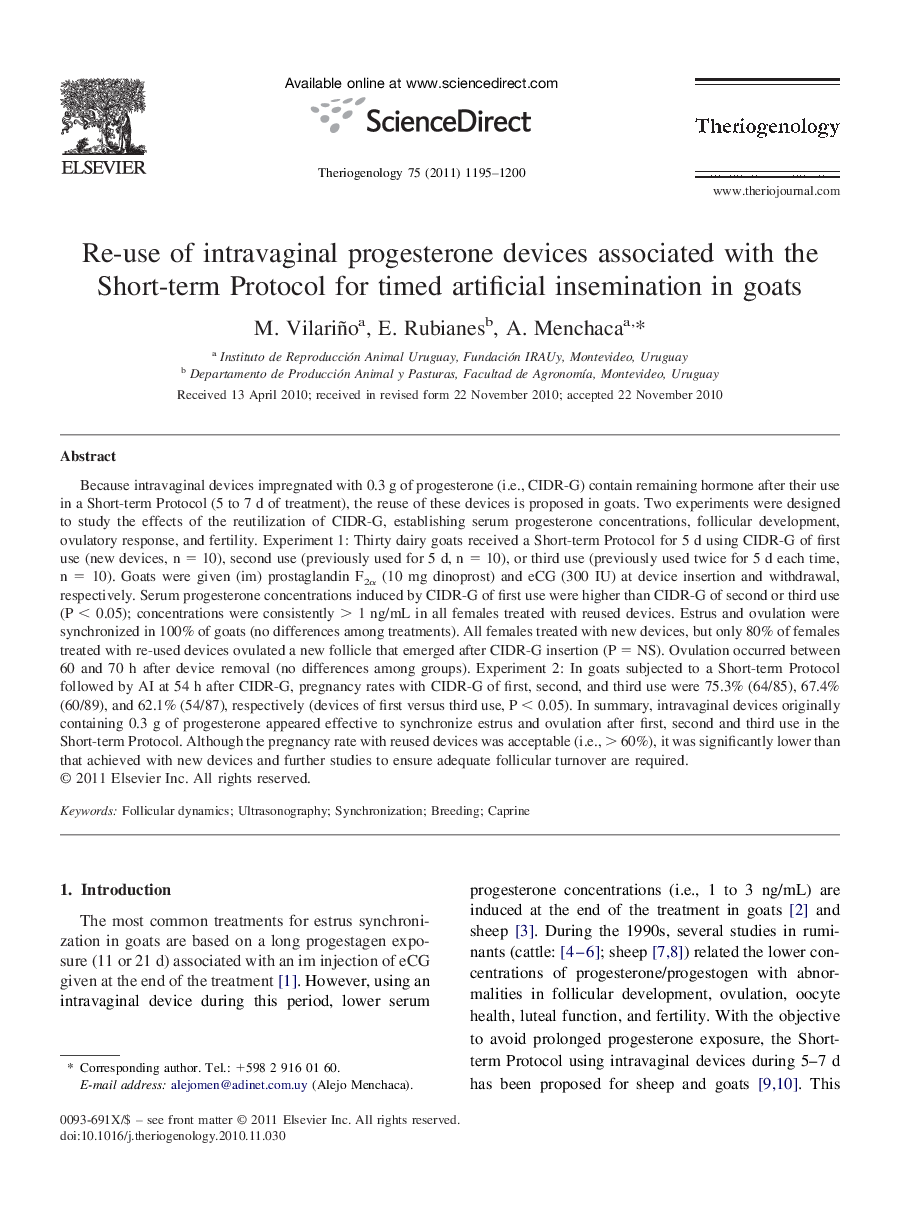| کد مقاله | کد نشریه | سال انتشار | مقاله انگلیسی | نسخه تمام متن |
|---|---|---|---|---|
| 10892798 | 1082118 | 2011 | 6 صفحه PDF | دانلود رایگان |
عنوان انگلیسی مقاله ISI
Re-use of intravaginal progesterone devices associated with the Short-term Protocol for timed artificial insemination in goats
دانلود مقاله + سفارش ترجمه
دانلود مقاله ISI انگلیسی
رایگان برای ایرانیان
کلمات کلیدی
موضوعات مرتبط
علوم زیستی و بیوفناوری
علوم کشاورزی و بیولوژیک
علوم دامی و جانورشناسی
پیش نمایش صفحه اول مقاله

چکیده انگلیسی
Because intravaginal devices impregnated with 0.3 g of progesterone (i.e., CIDR-G) contain remaining hormone after their use in a Short-term Protocol (5 to 7 d of treatment), the reuse of these devices is proposed in goats. Two experiments were designed to study the effects of the reutilization of CIDR-G, establishing serum progesterone concentrations, follicular development, ovulatory response, and fertility. Experiment 1: Thirty dairy goats received a Short-term Protocol for 5 d using CIDR-G of first use (new devices, n = 10), second use (previously used for 5 d, n = 10), or third use (previously used twice for 5 d each time, n = 10). Goats were given (im) prostaglandin F2α (10 mg dinoprost) and eCG (300 IU) at device insertion and withdrawal, respectively. Serum progesterone concentrations induced by CIDR-G of first use were higher than CIDR-G of second or third use (P < 0.05); concentrations were consistently > 1 ng/mL in all females treated with reused devices. Estrus and ovulation were synchronized in 100% of goats (no differences among treatments). All females treated with new devices, but only 80% of females treated with re-used devices ovulated a new follicle that emerged after CIDR-G insertion (P = NS). Ovulation occurred between 60 and 70 h after device removal (no differences among groups). Experiment 2: In goats subjected to a Short-term Protocol followed by AI at 54 h after CIDR-G, pregnancy rates with CIDR-G of first, second, and third use were 75.3% (64/85), 67.4% (60/89), and 62.1% (54/87), respectively (devices of first versus third use, P < 0.05). In summary, intravaginal devices originally containing 0.3 g of progesterone appeared effective to synchronize estrus and ovulation after first, second and third use in the Short-term Protocol. Although the pregnancy rate with reused devices was acceptable (i.e., > 60%), it was significantly lower than that achieved with new devices and further studies to ensure adequate follicular turnover are required.
ناشر
Database: Elsevier - ScienceDirect (ساینس دایرکت)
Journal: Theriogenology - Volume 75, Issue 7, 15 April 2011, Pages 1195-1200
Journal: Theriogenology - Volume 75, Issue 7, 15 April 2011, Pages 1195-1200
نویسندگان
M. Vilariño, E. Rubianes, A. Menchaca,